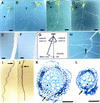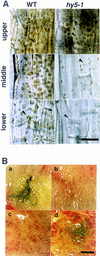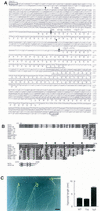The Arabidopsis HY5 gene encodes a bZIP protein that regulates stimulus-induced development of root and hypocotyl
- PMID: 9367981
- PMCID: PMC316701
- DOI: 10.1101/gad.11.22.2983
The Arabidopsis HY5 gene encodes a bZIP protein that regulates stimulus-induced development of root and hypocotyl
Abstract
Plant developmental processes are controlled by both endogenous programs and environmental stimuli. As a photomorphogenetic mutant, hy5 of Arabidopsis has been isolated and characterized. Our detailed characterization has revealed that the mutant is deficient in a variety of stimulus responses, including gravitropic response and waving growth of roots, as well as light-dependent hypocotyl elongation. In the roots and hypocotyl, the hy5 mutation also affects greening and specific cell proliferation such as lateral root formation and secondary thickening. Those phenotypes indicate that the HY5 gene is responsible for the regulation of fundamental developmental processes of the plant cell: cell elongation, cell proliferation, and chloroplast development. Molecular cloning of the HY5 gene using a T-DNA-tagged mutant has revealed that the gene encodes a protein with a bZIP motif, one of the motifs found in transcriptional regulators. Nuclear localization of the HY5 protein strongly suggests that the HY5 gene modulates the signal transduction pathways under the HY5-related development by controlling expression of genes downstream of these pathways.
Figures





Similar articles
-
A Lotus basic leucine zipper protein with a RING-finger motif negatively regulates the developmental program of nodulation.Proc Natl Acad Sci U S A. 2002 Nov 12;99(23):15206-10. doi: 10.1073/pnas.222302699. Epub 2002 Oct 23. Proc Natl Acad Sci U S A. 2002. PMID: 12397181 Free PMC article.
-
Dissection of HY5/HYH expression in Arabidopsis reveals a root-autonomous HY5-mediated photomorphogenic pathway.PLoS One. 2017 Jul 6;12(7):e0180449. doi: 10.1371/journal.pone.0180449. eCollection 2017. PLoS One. 2017. PMID: 28683099 Free PMC article.
-
Genome-wide mapping of the HY5-mediated gene networks in Arabidopsis that involve both transcriptional and post-transcriptional regulation.Plant J. 2011 Feb;65(3):346-58. doi: 10.1111/j.1365-313X.2010.04426.x. Epub 2010 Dec 30. Plant J. 2011. PMID: 21265889
-
The Multifaceted Roles of HY5 in Plant Growth and Development.Mol Plant. 2016 Oct 10;9(10):1353-1365. doi: 10.1016/j.molp.2016.07.002. Epub 2016 Jul 17. Mol Plant. 2016. PMID: 27435853 Review.
-
HY5: a key regulator for light-mediated nutrient uptake and utilization by plants.New Phytol. 2024 Mar;241(5):1929-1935. doi: 10.1111/nph.19516. Epub 2024 Jan 5. New Phytol. 2024. PMID: 38178773 Review.
Cited by
-
Genome-wide analysis and expression profile of the bZIP gene family in poplar.BMC Plant Biol. 2021 Mar 1;21(1):122. doi: 10.1186/s12870-021-02879-w. BMC Plant Biol. 2021. PMID: 33648455 Free PMC article.
-
Arabidopsis COP1 and SPA genes are essential for plant elongation but not for acceleration of flowering time in response to a low red light to far-red light ratio.Plant Physiol. 2012 Dec;160(4):2015-27. doi: 10.1104/pp.112.207233. Epub 2012 Oct 23. Plant Physiol. 2012. PMID: 23093358 Free PMC article.
-
The Half-Size ABC Transporter FOLDED PETALS 2/ABCG13 Is Involved in Petal Elongation through Narrow Spaces in Arabidopsis thaliana Floral Buds.Plants (Basel). 2014 Aug 15;3(3):348-58. doi: 10.3390/plants3030348. Plants (Basel). 2014. PMID: 27135508 Free PMC article.
-
Transposase-derived proteins FHY3/FAR1 interact with PHYTOCHROME-INTERACTING FACTOR1 to regulate chlorophyll biosynthesis by modulating HEMB1 during deetiolation in Arabidopsis.Plant Cell. 2012 May;24(5):1984-2000. doi: 10.1105/tpc.112.097022. Epub 2012 May 25. Plant Cell. 2012. PMID: 22634759 Free PMC article.
-
Arabidopsis cryptochrome 1 controls photomorphogenesis through regulation of H2A.Z deposition.Plant Cell. 2021 Jul 19;33(6):1961-1979. doi: 10.1093/plcell/koab091. Plant Cell. 2021. PMID: 33768238 Free PMC article.
References
-
- Aeschbacher RA, Schiefelbein JW, Benfey PN. The genetic and molecular basis of root development. Annu Rev Plant Physiol Plant Mol Biol. 1994;45:25–45.
-
- Ahmad M, Cashmore AR. HY4 gene of A. thaliana encodes a protein with characteristics of a blue-light photoreceptor. Nature. 1993;366:162–166. - PubMed
-
- Ausubel FM, Brent R, Kingston RE, Moore DD, Seidman JG, Smith JA, Struhl K. Current protocols in molecular biology. New York, NY: Greene/Wiley; 1987.
Publication types
MeSH terms
Substances
LinkOut - more resources
Full Text Sources
Other Literature Sources
Molecular Biology Databases
Research Materials
